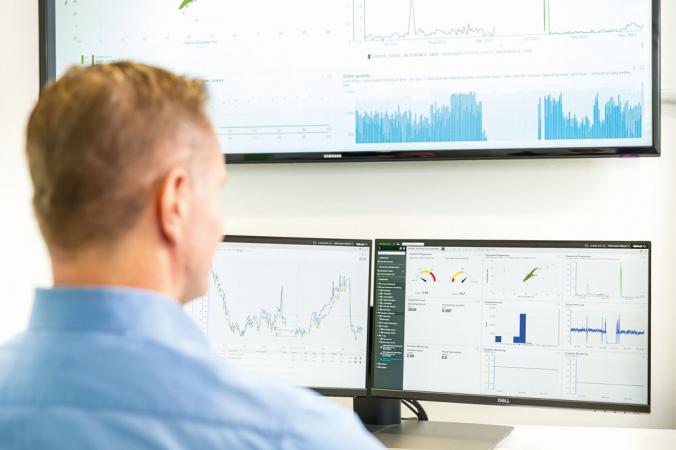Thermal Imaging Helps Spot the Problem
Heavy industries like mining, shipbuilding or crane work rely on heavy, rugged, industrial cables to ensure continuous power or communication performance. Whenever such a cable breaks, there is usually a big problem in terms of productivity, downtime and money lost.

German cable repair specialist Becker & Hüser GmbH helps its customers get back in business in the shortest amount of time. To offer their customers the quickest cable repair service possible the company uses thermal imaging cameras to locate exactly where the problem lies.
Based in Sonsbeck, in the German state of North Rhine-Westphalia, the company ( www.kabelreparatur.eu ) has been known for more than 30 years for its high quality cable repair services. This service provider has an experienced team of cable specialists for repairs either at the site of the customer or at the company plant. The service team is available 24/7 and will repair all types of copper cables, with or without fibre optics, in a wide range of industries, including brown coal open cast mining, ship building, the crane industry, railway systems and ports, gravel dredging facilities and conveyor systems.
Time Is Money in Repair
– The cables that our industrial customers are relying on are often used in harsh conditions. Think of the mining industry for example. Cables move around a lot, so it is no wonder that they are damaged and break from time to time. We are there to help companies with fast repair services, so they can reduce their downtime as much as possible, explains Mr. Andreas Becker, Managing Director at Becker & Hüser GmbH, the rationale behind its company’s activities.
– Companies do not always have cables in stock. So when a cable gets damaged, they will need to choose between repair and purchasing a new cable. The former option usually provides the highest time gains; waiting for a new cable sometimes requires months. We can repair a cable in a matter of weeks or days, sometimes even hours, says Andreas Becker.
This can really make a difference, for example in the case of cable damage on a ship that needs to leave the harbour. In addition, Becker & Hüser GmbH manages to return the cable to the customer as good as new, with the same properties, in terms of diameter, flexibility and tensile strength.
Traditional Detection Methods
Cable repair includes a lot of inevitable manual labour. Connecting the enormous tangle of fibres that eventually constitute the whole cable is a meticulous and time-consuming job for specialists. There is however, no magic trick to quickly locate a fault inside a cable when it comes to fault detection.
Becker & Hüser GmbH uses a surge voltage generator for locating and pinpointing high and low resistance faults in power cables. The stored energy of the high voltage capacitors is fed at intervals into the faulty cable. This causes noise at the fault position which can be detected either on sight, since a high voltage surge can generate sparks. Other methods may include feeling the cable with a rubber glove, or even by hearing.
Thermal Imaging for Fault Detection
Andreas Becker first learned about the possibilities of thermal imaging at a German tradeshow. We saw how quick and accurate thermal cameras can see voltage differences as heat differences. After that demonstration, we got in touch with FLIR Systems, who proposed their camera as a very cost-effective solution for fault detection. We are now using the E40bx with a 50° lens and MSX® functionality.
– For example, when a fault is located at the end of the cable, right at the connection, it is difficult to locate the fault using our traditional methods. Our thermal imaging camera however can see the heat difference without any problem. What’s more, detection with a thermal imaging camera will lead to an accurate result much faster, says Mr. Andreas Becker.
Cables are wound onto large reels. To inspect an entire cable, Becker & Hüser employees unwind the cable from one reel to another. While the cable is unwinding, the entire length can be inspected for faults by means of the thermal imaging camera. Seeing is believing. This saying is not only valid for the inspector, but also for its customers.
– It is an enormous advantage when you can show your customers exactly where the problem is. The thermal imaging camera allows you to do that. It is a matter of instilling confidence and showing your customer that you are on top of the problem, confirms Andreas Becker.
Point-and-Shoot Type Camera
The apparatus in use is a compact pointand shoot thermal imaging camera that combines the best performance and value in compact thermal imaging cameras. The camera is easy to use out of the box and offers a temperature range of -20 to +120°C (-4 to +248°F) with an accuracy of ±2 percent and a thermal sensitivity of below 0.045°C. The 160 x 120 pixel resolution provides high thermal image quality and a 3 megapixel digital camera provides fixed picture-in-picture, allowing the overlay of thermal and visible images for easy location identification and clearer documentation.
A laser pointer aids targeting while a bright LED lamp provides light in dark corners. The camera can be linked via Wi-Fi to an iPad or iPhone, allowing users to transfer images, add further measurement spots, re-adjust span and level, change palettes, create reports, and email findings to decision makers or customers easily.










